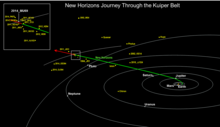astro.wikisort.org - Asteroid
2011 KW48, temporarily designated VNH0004, is a trans-Neptunian object from the inner classical part of the Kuiper belt, located in the outermost region of the Solar System. It measures approximately 77 kilometers (48 mi) in diameter.
| Discovery[1] | |
|---|---|
| Discovered by | New Horizons KBO Search (266) |
| Discovery site | Subaru Telescope |
| Discovery date | 29 May 2011 (discovery: first observed only) |
| Designations | |
MPC designation | 2011 KW48 |
Alternative designations | VNH0004 |
Minor planet category | TNO[1] · inner classic[2] distant[3] |
| Orbital characteristics[1] | |
| Epoch 8 June 2011 (JD 2455720.5) | |
| Uncertainty parameter n.a.[1][3] | |
| Observation arc | 34 days |
| Aphelion | 42.676 AU |
| Perihelion | 32.368 AU |
Semi-major axis | 37.522 AU |
| Eccentricity | 0.1374 |
Orbital period (sidereal) | 229.84 yr (83,950 days) |
Mean anomaly | 347.91° |
Mean motion | 0° 0m 15.48s / day |
| Inclination | 3.6328° |
Longitude of ascending node | 246.15° |
Argument of perihelion | 46.931° |
| Physical characteristics | |
Mean diameter | 77 km[2] |
Geometric albedo | 0.09 (estimate)[2] |
Absolute magnitude (H) | 8.8[1] |
The object was first observed on 29 May 2011, during the New Horizons KBO Search (266) conducted by astronomers using the Subaru Telescope at the Mauna Kea Observatory on Hawaii, United States.[3] It was later observed by the New Horizons space probe from afar in January 2015.[4][5]
Orbit and classification
2011 KW48 orbits the Sun at a distance of 32.4–42.7 AU once every 229 years and 10 months (83,950 days; semi-major axis of 37.5 AU). Its orbit has an eccentricity of 0.14 and an inclination of 3.6° with respect to the ecliptic.[1]
This object was observed 12 times by the Mauna Kea (8) and Las Campanas (4) observatories over a period of about 33.8 days between 29 May and 2 July 2011. Because of this short period of observation, its current orbit is extremely uncertain.[1][3]
New Horizons

Between 4–15 January 2015,[4] the New Horizons spacecraft actively observed this object – then temporarily designated VNH0004 – at a distance of about 0.5 AU (75 million km; 46 million mi).[5] While this was too far to resolve surface features or perform spectroscopic analyses of its composition, the spacecraft was able to search for possible satellites and observe its phase curve.[5] If 2011 KW48 were 100 kilometers (60 mi) wide, it would have appeared approximately 0.11 arcseconds wide to New Horizons.
Physical characteristics
Based on an absolute magnitude of 8.8,[1] and an assumed albedo of 0.09, the Johnston's archive estimates a mean-diameter of approximately 77 kilometers (48 mi).[2] As of 2018, no rotational lightcurve of 2011 KW48 has been obtained from photometric observations. The object's rotation period, pole and shape remain unknown.[1][6]
Numbering and naming
As of 2018, this minor planet has not been numbered or named.[3]
See also
- List of New Horizons topics
References
- "JPL Small-Body Database Browser: (2011 KW48)" (2011-07-02 last obs.). Jet Propulsion Laboratory. Retrieved 7 February 2018.
- Johnston, Wm. Robert (30 December 2017). "List of Known Trans-Neptunian Objects". Johnston's Archive. Retrieved 7 February 2018.
- "2011 KW48". Minor Planet Center. Retrieved 7 February 2018.
- Gebhardt, Chris (19 January 2015). "New Horizons begins Pluto observations ahead of July flyby". NASASpaceFlight.com. Retrieved 7 February 2018.
- Paul, Christopher (31 August 2012). "New Horizons to Encounter KBO Ahead of Pluto Flyby". AmericaSpace. Retrieved 7 February 2018.
- "LCDB Data for (2011 KW48) – Not yet in Data Base". Asteroid Lightcurve Database (LCDB). Retrieved 7 February 2018.
External links
- Orbit Fit and Astrometric record for VNH0004, Southwest Research Institute, 25 October 2014
- List of Transneptunian Objects, Minor Planet Center
- Asteroid Lightcurve Database (LCDB), query form (info Archived 16 December 2017 at the Wayback Machine)
- 2011 KW48 at the JPL Small-Body Database
На других языках
- [en] 2011 KW48
[ru] 2011 KW48
2011 KW48 (ранее VNH0004) — транснептуновый объект из пояса Койпера.Другой контент может иметь иную лицензию. Перед использованием материалов сайта WikiSort.org внимательно изучите правила лицензирования конкретных элементов наполнения сайта.
WikiSort.org - проект по пересортировке и дополнению контента Википедии
